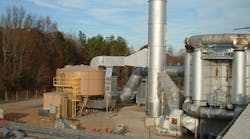After operating two regenerative thermal oxidizers (RTOs) for the past 25 years, Soliant LLC, South Carolina (www.paintfilm.com) approached Dürr Systems, Inc. Environmental and Energy Systems (www.durr.com) to assess and recommend repairs that would keep the RTOs running reliably with high volatile organic compound (VOC) destruction efficiency.
Dürr found that the old oxidizers had been designed to accommodate significantly higher VOC loads. Under current operating conditions, the old oxidizers were gas hogs. In 2006, they consumed 56,675 dekatherms at an average of $10.78/dth, a total of $610,956, or $50,913 per month. Dürr recommended replacement of the oxidizers with more efficient units.
“Soliant was interested in the oxidizer replacement project and the energy savings it would generate, but they already had budgeted their capital resources for expanding production to meet increasing demand,” says Jim Griffin, Dürr regional sales manager. “It’s a story I hear frequently from customers and it’s the primary reason Dürr began financing energy projects.”
In December 2007, Dürr installed a new RL60 rotary-valve RTO to replace Soliant’s old oxidizers.
Dürr offered to finance the project, which required no capital investment from Soliant. As part of the arrangement, Soliant agrees to pay Dürr a fixed monthly fee from the natural gas savings generated by the RTO replacement. Dürr guarantees the RTO’s measurable thermal efficiency for the full contract term. The contract also includes bonuses for exceeding the guaranteed thermal efficiency and penalties for falling short of the guarantee. This means that if the RTO performance falls below the guaranteed level, Dürr pays for Soliant’s additional gas usage and has an incentive to address the issue immediately.
“As a small company, we thought it was a good way to implement a greener solution without a large capital outlay,” says Jeff Bailey, vice president of operations for Soliant. “The performance guarantee ensured both sides have a vested interest in improvement.”
It’s not uncommon that savings from energy projects begin to deteriorate long before the payback period expires. The Energy Performance Contract tackles this issue by putting the risk of ongoing performance on the equipment supplier while giving both the end user and the supplier a vested interest in continuous monitoring and system tune-ups to maximize energy savings.
In December 2007, Dürr installed a new RL60 rotary-valve RTO to replace Soliant’s old oxidizers. The system went online Dec. 17, 2007, and the Energy Performance Contract went into effect Jan. 1, 2008. Through June 2008, the new RL60 has reduced Soliant’s gas usage for VOC abatement by 85%. With its long-term gas supply contract ending in June 2008, Soliant is now looking at a spot gas price for uninterruptible service of $15/dth and a contract price of $14/dth. At its current contract natural gas price, the RTO replacement project saves Soliant an average of $56,500 per month.
Dürr estimated the cost to repair the aging units at about $250,000. By deciding not to invest in the old equipment, Soliant felt that it also would achieve a significant reduction in maintenance costs. “There’s really no comparison between the old and the new equipment,” Bailey says. “The old system had 42 hydraulic valves for controlling air flow, which were a maintenance headache. The new Dürr unit has a single rotating valve that requires minimal service and is a much simpler design.”
Overall, Soliant’s net monthly operating expense has been reduced as a result of the performance contract, because the average natural gas savings exceeds the monthly payment for the equipment. As an additional benefit, at the end of the contract term, Soliant will own the equipment outright and thus keep the energy savings for themselves.
“Soliant was in a position where its production depended on the operation of two 25-year-old oxidizers that cost them $66,000 per month in gas alone. By using the EPC to fund the RTO replacement, at the end of the contract it will have cost them only $9,600 per month to run,” Griffin says.
The approach supports the company’s long-term strategies. “Our goal is to offer environmentally friendly products and push for more efficient equipment leading to reduced energy consumption,” says Jerry Patton, Soliant’s president. “This equipment is helping us accomplish that goal.”
